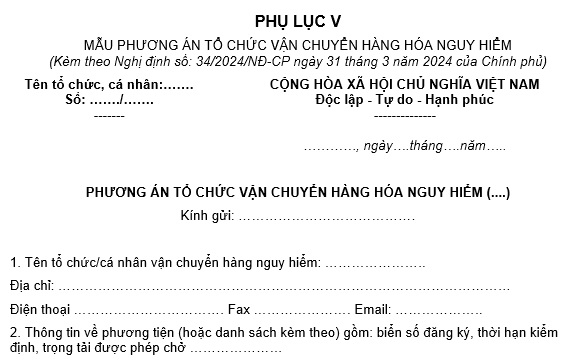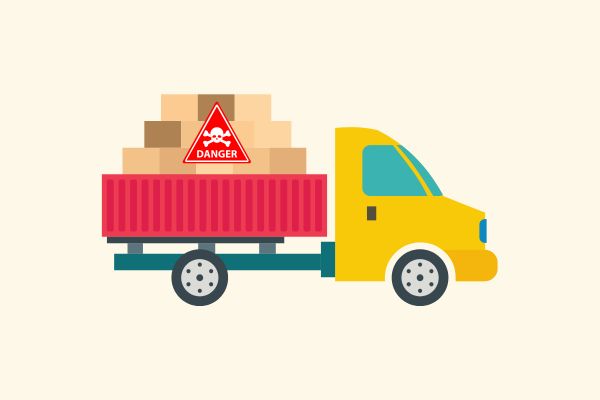Vietnam: What are the details of dangerous goods transport plan template as per Decree 34/2024/ND-CP?
What are the details of dangerous goods transport plan template as per Decree 34/2024/ND-CP?
Based on Appendix V attached to Decree 34/2024/ND-CP regulating the dangerous goods transport plan in Vietnam:
The dangerous goods transport plan template is as follows:

>> Dangerous goods transport plan template: Download

Dangerous goods transport plan template 2024 as per Decree 34/2024/ND-CP (Internet image)
What are the requirements for participants in transport of dangerous goods and vehicles carrying dangerous goods in Vietnam?
According to Article 9 of Decree 34/2024/ND-CP, the requirements for participants in transport of dangerous goods and vehicles carrying dangerous goods in Vietnam are regulated as follows:
Conditions for participants in transport of dangerous goods
1. The driver of the vehicle transporting dangerous goods must ensure that they have sufficient conditions to operate the vehicle and have been trained and certified to have completed the safety training program for dangerous goods as stipulated in this Decree.
2. Attendants, warehouse keepers, and loaders/unloaders must be trained in safety and certified to have completed the safety training program for the particular type of dangerous goods they are supervising, loading, or unloading or storing.
Moreover, Article 10 of Decree 34/2024/ND-CP outlines the conditions for vehicles transporting dangerous goods as follows:
Conditions for vehicles carrying dangerous goods
1. The transporting vehicle must meet the conditions to participate in traffic as per legal regulations. Special equipment for vehicles transporting dangerous goods must meet national standards or technical regulations or as specified by the sector managerial ministry.
2. The vehicle transporting dangerous goods must display the dangerous goods symbol. If multiple types of dangerous goods are transported on one vehicle, the vehicle must display all respective symbols of those goods. The symbols must be placed on both sides, front, and rear of the vehicle to ensure visibility and recognition.
3. After offloading all dangerous goods, if the vehicle does not continue transporting the same type of goods, it must be cleaned, and the dangerous symbols must be removed or obliterated from the vehicle. The transport company and the vehicle driver are responsible for cleaning and removing or obliterating the dangerous symbols from the vehicle when no longer transporting those types of dangerous goods.
Thus, from May 15, 2024, the conditions for vehicles and participants in the road transport of dangerous goods include:
(1) Conditions for participants in the transportation of dangerous goods:
- Conditions for vehicle drivers:
+ The driver must have the necessary skills and training in dangerous goods safety and hold a certification of completion as per the regulations.
- Conditions for attendants, warehouse keepers, and loaders/unloaders:
+ Must be trained in safety and certified in the safety training program for the specific type of dangerous goods they supervise, load, unload, or store.
(2) Conditions for vehicles transporting dangerous goods:
- The vehicle must meet technical standards and specialized equipment as specified by law and the sector managerial ministry.
- Must display the necessary dangerous goods symbols in visible positions.
If multiple types of dangerous goods are transported on one vehicle, all respective symbols must be displayed, ensuring visibility from both sides, front, and rear of the vehicle.
- After offloading all dangerous goods, the vehicle must be cleaned and the dangerous symbols must be removed or obliterated.
The transport company and the vehicle driver are responsible for cleaning and removing or obliterating the dangerous symbols from the vehicle when no longer transporting those types of dangerous goods.
How many classes and divisions of dangerous goods in Vietnam are there?
According to Article 4 of Decree 34/2024/ND-CP, dangerous goods are classified as follows:
Depending on the chemical and physical properties, dangerous goods are classified into 9 types and the following groups:
- Type 1. Explosive materials and items:
+ Group 1.1: Substances and items with a widespread explosion risk.
+ Group 1.2: Substances and items with a projection hazard but no widespread explosion risk.
+ Group 1.3: Substances and items with a fire and minor explosion risk or minor projection hazard or both, but no widespread explosion risk.
+ Group 1.4: Substances and items with a negligible hazard.
+ Group 1.5: Insensitive substances with a widespread explosion risk.
+ Group 1.6: Extremely insensitive items without widespread explosion risk.
- Type 2. Gases:
+ Group 2.1: Flammable gases.
+ Group 2.2: Non-flammable, non-toxic gases.
+ Group 2.3: Toxic gases.
- Type 3. Flammable liquids and desensitized liquid explosives;
- Type 4:
+ Group 4.1: Flammable solids, self-reactive substances, and solid desensitized explosives.
+ Group 4.2: Substances liable to spontaneous combustion.
+ Group 4.3: Substances which, on contact with water, emit flammable gases.
- Type 5:
+ Group 5.1: Oxidizing substances.
+ Group 5.2: Organic peroxides.
- Type 6:
+ Group 6.1: Toxic substances.
+ Group 6.2: Infectious substances.
- Type 7: Radioactive materials;
- Type 8: Corrosive substances;
- Type 9: Miscellaneous dangerous substances and articles.
Therefore, dangerous goods are classified into 9 types, with type 1 having 6 groups, type 2 having 3 groups, type 4 having 3 groups, type 5 having 2 groups, and type 6 having 2 groups.
LawNet